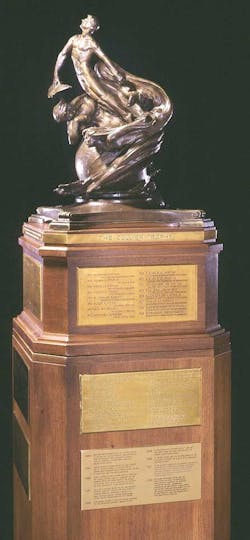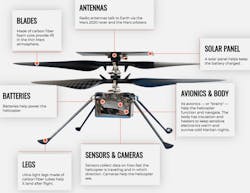Mars Ingenuity Helicopter Earns its Developers the Collier Trophy
Ingenuity, the helicopter deployed to Mars by NASA, earned the 2021 Robert J Collier Trophy from the National Aeronautic Association for being the first aircraft to conduct powered, controlled flight on another planet. The more-than-a-century-old Collier Trophy is awarded each year, marking major achievements in aviation.
The helicopter was developed by a team of engineers from NASA’s Jet Propulsion Laboratory (JPL), AeroVironment, and maxon.
The helicopter was built by AeroVironment, a company that specializes in unmanned air vehicles, under contract from JPL. Maxon provided six precision DC motors, each with a diameter of only 10 mm; they move the swashplates on the rotors. Swashplates, which are found on all helicopters, adjust the angle of the rotor blades and control the helicopter’s flightpath. The Perseverance rover, the spacecraft that carried the helicopter to the surface of Mars, also relies on maxon motors to collect and store soil samples that will be retrieved from Mars on a future NASA mission.
It took intense engineering work to design a small helicopter that can fly in the thin atmosphere of Mars. Though Ingenuity never flew more than 40 ft above the Martian surface, the atmospheric pressure at that point is equivalent to being 98,500 ft above the Earth. This means the helicopter had to be extremely light, and it was; it weighs in at just under 4 lb. The weight limitations meant the solar-charged batteries and maxon DC motors also had to be light and highly energy efficient.
The helicopter was designed as a technology demonstrator to test the ability of flying a battery-powered helicopter on Mars and scheduled for five flights. But after successfully carrying out those flights, NASA decided to use it operationally on at least 19 more flights as a scout to checkout areas for the Perseverance rover to collect samples.
Ingenuity also carries a piece of fabric from the wing of the Wright Bother’s 1903 Wright Flyer, the first heavier-than-air to achieve controlled flight. And Ingenuity's initial take-off and landing area on Mars was named Wright Brothers Field in tribute.
“We’re very proud to have joined the team of AeroVironment and JPL at the Collier Trophy award ceremony and share this great honor,” says Florbela Costa, maxon’s SpaceLab project manager. The SpaceLab is an organization within maxon that specializes in developing high risk new technologies for space missions, as well as supporting the growing commercial space market with high reliability actuators suitable for the harsh environment of space.


